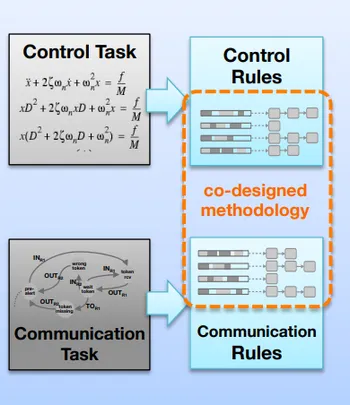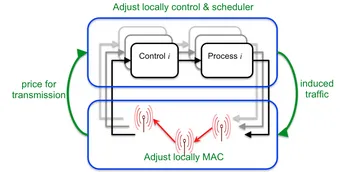- Decentralized LQ-Consistent Event-Triggered Control Over a Shared Contention-Based Network. IEEE Transactions on Automatic Control 67 (3), 2022, 1430 - 1437 mehr… BibTeX
- Feedback Control over Noisy Channels: Characterization of a General Equilibrium. IEEE Transactions on Automatic Control, 2021 mehr… BibTeX
- Value of Information in Feedback Control: Quantification. IEEE Transactions on Automatic Control, 2021 mehr… BibTeX
- Finite-Time Distributed Topology Design for Optimal Network Resilience. IET CONTROL THEORY AND APPLICATIONS, 2019 mehr… BibTeX
- Human-Robot Team Interaction Through Wearable Haptics for Cooperative Manipulation. IEEE Transactions on Haptics, 2019 mehr… BibTeX
- Age-of-Information vs. Value-of-Information Scheduling for Cellular Networked Control Systems. International Conference on Cyber-Physical Systems, 2019 mehr… BibTeX
- Distributed Link Removal Using Local Estimation of Network Topology. IEEE Transactions on Network Science and Engineering, 2018 mehr… BibTeX
- Try-Once-Discard Scheduling for Stochastic Networked Control Systems. International Journal of Control, 2018, 1-15 mehr… BibTeX
- Bounded Consensus of Linear Multi-Agent Systems with External Disturbances Through a Reduced-Order Adaptive Feedback Protocol. 37th Chinese Control Conference (CCC), IEEE, 2018 mehr… BibTeX
- Optimal LQG Control under Delay-dependent Costly Information. IEEE Control Systems Letters 3 (1), 2018, 102-107 mehr… BibTeX
- Distributed Topology Manipulation to Control Epidemic Spreading over Networks. IEEE Transactions on Signal Processing 67 (5), 2018, 1163-1174 mehr… BibTeX
- LQG Control via Wireless Sensor Networks with Minimal Transmission Power. Workshop on Discrete Event Systems (WODES), 2018 mehr… BibTeX
- Information-constrained Optimal Control of Distributed Systems with Power Constraints. European Control Conference (ECC), 2018 mehr… BibTeX
- State-dependent Data Queuing in Shared-resource Networked Control Systems. 57th IEEE Annual Conference on Decision and Control (CDC), IEEE, 2018 mehr… BibTeX
- Covariance-Based Transmission Power Control for Estimation over Wireless Sensor Networks. European Control Conference (ECC), 2018 mehr… BibTeX
- Energy management in a multi-building setup via distributed stochastic optimization. American Control Conference (ACC), 2018, 2018 mehr… BibTeX
- Towards In-Network Industrial Feedback Control. ACM SIGCOMM, 1st Workshop on In-Network Computing (NetCompute 2018), 2018 mehr… BibTeX
- Event-Triggered Output-Feedback H∞ Control with Minimum Directed Information. Proceedings of the Conference on Decision and Control (CDC), 2017 mehr… BibTeX
- Value of Information in Minimum-Rate LQG Control. In Proceedings of the International Federation of Automatic Control World Congress, 2017 mehr… BibTeX
- Prioritized contention resolution for random access networked control systems. Conference on Decision and Control (CDC), IEEE, 2017, 6689-6695 mehr… BibTeX
- Event-Triggered State Estimation: An Iterative Algorithm and Optimality Properties. IEEE Transactions on Automatic Control 62 (11), 2017, 5939-5946 mehr… BibTeX
- On Three-dimensional Formation Control with Mismatched Coordinates. IEEE Transactions on Control of Network Systems 5 (3), 2017, 1492-1502 mehr… BibTeX
- Optimal Stationary Self-Triggered Sampling for Estimation. In Proceedings of the Conference on Decision and Control (CDC), 2016 mehr… BibTeX
- Optimal Information Control in Cyber-Physical Systems. IFAC Workshop on Distributed Estimation and Control in Networked Systems, 2016 mehr… BibTeX
DFG Priority Programme Cyber-Physical Networking (SPP 1914)
The increase of data rates of communication systems has been one of the main research objectives of the past decades leading to the modern information society of today. Recently, we see a rapid spread of cyber-physical applications such as telemedicine, smart production and infrastructure systems. In such systems feedback control loops are closed over the communication channel imposing real-time requirements on the communication system. Predictably low latency is generally a desirable property, however, it challenges concurring requirements for high reliability, spectral and energy efficiency of the communication system in particular in wireless communication. Classical approaches for the independent design of communication and control have clearly reached their limits.
The goal of the Priority Programme SPP 1914 is to develop the theoretical basis for the paradigmatic change from throughput- to real-time-oriented communication for networked control systems. In order to meet the requirements of cyber-physical applications a tight (horizontal and vertical) integration of all communication, control and system components is needed to fully exploit their individual elasticity and mutual adjustment potential. Ultimately, this requires joint communication, control and systems design methodologies. The Priority Programme aims at developing system-wide concepts and theories of modelling, analysis, coordination, and optimisation of the communication system and its components for networked control systems and real-time sensitive applications. It requires a novel unified consideration of models and methods from communication networks and systems, control, and information theory.
A Co-Designed Architecture for In-Network Control
ITR participates in the subproject "Reflexes: A Co-Designed Architecture for In-Network Control" in collaboration with the " Chair of Communication and Distributed Systems at RWTH Aachen University" (TUM).
Recent technological developments in sensing, communication, control and computation have fostered an emerging class of complex applications, called Cyber-Physical Systems (CPS). In these networks, a process is no longer bound to a specific independent device, but coordinated between several interdependent network nodes; and therefore distributed via a communication network. CPS are making inroads into an ever increasing number of application domains such as industrial automation (Industry 4.0), energy, transport, and health care systems. The deployment of CPS promises considerable benefits, including increased flexibility, efficiency, and adaptability.
However, the traditional separate and layered design of communication and control architecture prevents the ubiquitous adoption of CPS as the communication-induced unreliability and latency compromises the quality-of-control and may even lead to dangerous behavior. The core concept of the project has an analogy in nature: Within the human body reflexes are fast pre-defined simple action patterns, which are located in the spinal cord, i.e. close (in the sense of low transmission latency) to the sensors and actuators. Higher-level planning and control mechanisms are located farther away in the brain.
Therefore, the goal of this project is to develop a novel co-designed architecture for communication and control to facilitate the best possible performance of CPS given the available communication and computation resources. We introduce the novel paradigm of in-network control, which pushes control functionalities as close as possible to the process to be controlled exploiting the computational power of active network components - even if limited. We will move away from the ‘traditional’ layered communication architecture and deploy in-network processing of simple control commands bypassing the classical protocol stack. In short, the general objective of this project is to reduce the communication distance of control messages as much as possible (horizontally, in the number of hops, and vertically, in the time for processing) and to increase reliability by introducing deterministic processing of such messages. As a result unnecessary time delays and unreliability within the closed control loop are avoided leading to the best possible quality-of- control. The key methodical contributions of this project are i) a novel approach to distribute the control on a given communication and computation infrastructure including appropriate analysis tools for performance evaluation, ii) a novel software framework for in-network processing with real-time constraints by co-designing the execution of control and communication procedures in a single and fundamentally new methodology.
Optimal Co-Design of Wireless Resource Management and Multi-Loop Networked Control
ITR participates in the subproject "Optimal Co-Design of Wireless Resource Management and Multi-Loop Networked Control" in collaboration with the " Chair of Communication Networks" (TUM).
The objective of this project is to develop a framework for the co-design of communication and control, concretely for the optimal co-design of the wireless resource management in terms of medium access control and networked multi-loop control.
Our key contributions are
- a deep understanding of the relationship between the achievable control performance, communication network parameters and control system parameters based on analytic models
- novel optimal control and scheduling designs under resource constraints,
- novel mechanisms for medium access in multi-hop wireless networks with real-time requirements
- a (near-) optimal layering architecture and co-design for wireless communication and control over wireless multi-hop networks
We take the scenario of multiple independent control loops accessing one shared wireless communication channel as our starting point. In particular, we consider control systems with heterogeneous linear time invariant processes and a typical wireless network medium access control based on a slotted aloha principle. We investigate the wireless network resource management and control performance trade-off, propose new models for a joint consideration and explore their fundamental limits in terms of scale and performance.
Based on the decomposition of the overall optimization problem, we will derive a novel approach for the control and scheduling design as well as new network resource management schemes to support a co-design. We will provide a first optimal system co-design through the solution of the decomposed optimization problem. A key focus is put on finding fundamental results. Preliminary findings of a joint work of the two proposers’ collaborating research groups suggest a high benefit from the joint modelling and co-design strategies.

